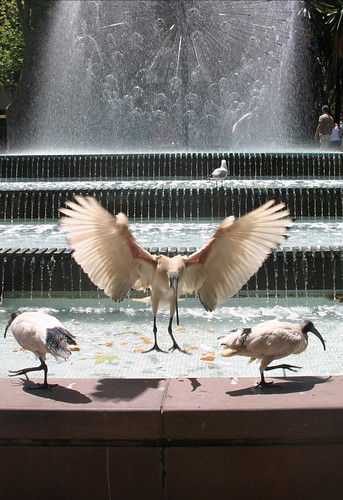
I recently found my old copy of The Diaries Of Paul Klee, 1898-1918 (University of California Press, 1968). Opening the book at random, I found these two marvellous entries:
954. Dream: I asked the geishas only for a little music and some “of the tea that serves as a manifold substitute for all the geishas of the world.”
At the slightest temptation I heard a soft knocking. When I followed the knocking, a small sprite stretched out his tiny hand to me and led me gently upward into his region.
There, things fell up, not down. A light breakfast, including eggs, was appetisingly laid out on the ceiling.
956. What the war meant to me was at first something largely physical: that blood flowed near by. That one’s own body could be in danger, without which there is no soul! The reservists in Munich, singing foolishly. The wreathed victims. The first sleeve turned up at the elbow, the safety pin on it. The one long leg, clad in Bavarian blue, taking huge strides between two crutches. The actualization of the letter of the history book. The coming to life of the pages of old picture books. Even though no Napoleon appeared, but merely a lot of Napoleonettos. The whole business had as much sense to it as a wad of dung on a shoe heel.
These are diary entries on two completely different subjects, a seemingly pleasant dream and memories of the First World War (in which Klee was a Private). They are united by the delicacy and meticulousness of Klee's description, his eye for the surreal, eidetic image. Nothing is over-explained; the sensory details are given without embellishment and the effect is both mysterious and utterly down to earth, much like Klee's paintings and drawings.
There are many of these that stay in my memory. One of the first I encountered (in a book) was The Twittering Machine, a sketchy cartoon depicting some kind of organic-mechanical apparatus involving birdlike heads and a winch. I am reminded of street organs, birds on a wire, and (out of my personal rag and bone shop) Yeats’s Byzantine bird ‘of hammered gold and gold enamelling’. That’s part of the Klee magic, that his seemingly artless (or childlike) paintings and drawings set off so many artful associations and allusions.
Of course, anything bobbing up in the usually muddy, everyday flow can trigger associations, memories, images and so on. But with Klee’s art, as with the art of many masters, one has the sensation of being guided, persuaded ever so gently. The titles of his paintings lend a hand in this process: ‘Head of Man (Going Senile)’, ‘Ancient Sound’, ‘Fish Magic’, ‘Furnished Arctic’…
Klee’s work can be utterly delicate, fine as a butterfly’s wing, like the layered abstraction of ‘Highways And Byways’, or comprised of a handful of bold, dark strokes, like the simple, picassoesque ‘Tennis Player’. It often involves landscapes and/or figures (or perhaps just one face), usually only partly representative of humans, sometimes more animal or plant (but again only partly representative) or sometimes more of the realm of pure design, like many of Miro’s paintings. The distortions (to figures, landscapes, animals etc.) are never grotesque – unless grotesqueness is called for – and never so violent that one refuses to assimilate them. In his encouragingly slim book, 'On Modern Art', Klee puts it succinctly: 'I do not wish to represent man as he is, but as he might be.' The same goes for the flora (branches and leaves especially) and fauna (Klee has a particular fondness for snakes, birds and fish, creatures that carry a free-floating, give-or-take symbolism and whose lines and shapes translate naturally to outlines and flattened, appliqué designs).
Everything in a Klee painting or drawing is of a piece with that painting or drawing, that worldlet. Klee's works are almost always perfectly balanced meeting places for abstract and figurative, process and depiction, and many of the canvasses are framed to display their fraying edges, the shorelines of their illusions.
One of the more abstract paintings (the wonderfully titled ‘Ancient Sound’) is composed of rough but precise squares of colour, grey-green, earth-dark and black near the edges, jade, orange, vanilla and pale yellow at the centre, all tilting very slightly to the right. Were the squares more hard and symmetrical, more graphic, one could be looking at a digital image, pixelated but almost in focus, an emerging mountain or cave perhaps. But the painting is much more organic and earthy, and the thready texture of the canvas is clearly visible, part of the orchestrated effect. The first time I saw a reproduction of this painting I immediately thought of music, brassy, organ-deep notes (like the four window-shattering snorts from the big flying saucer in Close Encounters). I tried once to write a poem about this and failed dismally, one more example of what one friend called ‘giggling at laughing’.
Suffice to say Klee’s landscapes, creatures, still lives or abstracts are perpetually fresh, recognisable as pristine manifestations of Klee-world, or Cloverworld: Klee is apparently German for clover. I learnt that interesting little fact from Tom Paulin's brilliant poem about Klee's period in the army, when he 'endured "horribly boring guard duty" at the gasoline cellar' on an airfield. Klee apparently passed the time by laying out a garden between the runways, where regularly crashed biplanes provided him with an unlikely bonus. As Paulin puts it: 'maybe the pilots annoyed him?/ those unlovely aristos / who never knew they were flying / primed blank canvases / onto his beautiful airfield.' (from 'Walking The Line', Faber).
No comments:
Post a Comment